If you’ve ever sent an email campaign and watched half your messages bounce or land in spam, you already know why email verification matters.
Email verification checks whether an email address is real, active, and ready to receive messages. Think of it as a quick “ID check” before you hit send.
But in 2025, it’s more important than ever. Inboxes are smarter, spam filters are tougher, and users are quicker to block unwanted mail. That means every invalid or risky email address can hurt your deliverability and your reputation.
Verified lists don’t just keep your emails out of spam; they also boost:
- Deliverability → more messages reach real people.
- Security → fewer chances of phishing or fake sign-ups.
- ROI → less waste on bad data and bounced sends.
That’s where the best email verification API tools come in. They make it easy to clean, validate, and monitor your lists automatically.
In this guide+listicle, you’ll learn how to choose the right API for email verification, integrate it smoothly, and keep your campaigns performing at their best, all with less effort and more confidence.
Want to learn more? Let’s start by looking at what these APIs do and how they can help you.
Clean lists start here
Tired of bounces and spam folders? Start verifying your emails in seconds with Generect’s real-time API and see how much cleaner your campaigns feel.
What exactly is an email verification API?
An email verification API is a tool that checks whether an email address is real, active, and safe to use automatically, and in real time.
You plug it into your app, website, or CRM, and it quietly does the background work of cleaning up your email lists.
Every time someone types an email address into a signup form, the API quickly runs a few checks before letting it in. That’s how businesses keep fake or misspelled emails from cluttering their systems (and wasting marketing dollars).
Behind the scenes, it runs through several steps:
- Syntax check → it looks for typos or formatting issues (like missing “@” or “.com”).
- Domain validation → it confirms the domain actually exists and can receive mail.
- Mailbox ping → it pings the server without sending an actual message to check if the mailbox is active and ready.
These quick steps take milliseconds but can save you from wasted sends, spam complaints, and reputation damage.
You can use an email verification API in tons of ways. Plug it into your signup forms to catch typos instantly. Connect it with your CRM so your sales team only contacts verified leads. Or, add it to your marketing automation tools to keep your campaigns clean and deliverable.
If you’re just getting started, try a free email verification API, like Generect. Most offer a few hundred verifications per month, which is perfect for testing or smaller lists. Once you see how much cleaner your results get, upgrading to a paid plan feels like a no-brainer.
An email verification API is your silent partner for better deliverability, higher engagement, and a spotless sender reputation.
Next, let’s take a look at what we focused on when choosing the tools we’ll discuss in this article.
How did we pick the best tools for this list?
With so many email verification APIs out there, choosing the right ones can feel overwhelming. So instead of just listing popular names, we looked at what really matters in 2025: performance, reliability, and value.
We started by testing each tool in real scenarios: verifying bulk lists, integrating with CRMs, and checking how well they handled fake or risky emails. From there, we scored them based on a few key factors:
- Reliability and accuracy → the best APIs consistently identify bad emails and keep bounce rates low.
- Ease of integration → you should be able to plug an API into your system without hours of coding or complex setup.
- Customer feedback → we looked at reviews from real users, including marketers, developers, and business owners, to see what’s working and what’s not.
- Cost-effectiveness → price matters, but so does value. We focused on tools that offer strong features at fair prices.
This list is fully updated for 2025, reflecting the latest data, user feedback, and performance insights.
Our goal is to help you pick an email verification API that’s not only powerful but also easy to use every day, one that works quietly in the background while you focus on growing your business.
So, which tools do we suggest taking a closer look at? Let’s find out.
What are the best email verification API tools to use in 2025?
Now that you know what an email verification API does and how we picked them, let’s get to the good part: the tools themselves.
In 2025, accuracy and automation are everything. No matter if you’re running a marketing campaign, managing a CRM, or building a signup flow, you need tools that just work: fast, precise, and easy to integrate.
That’s where the best email verification API options come in. So, let’s explore them.
Generect API
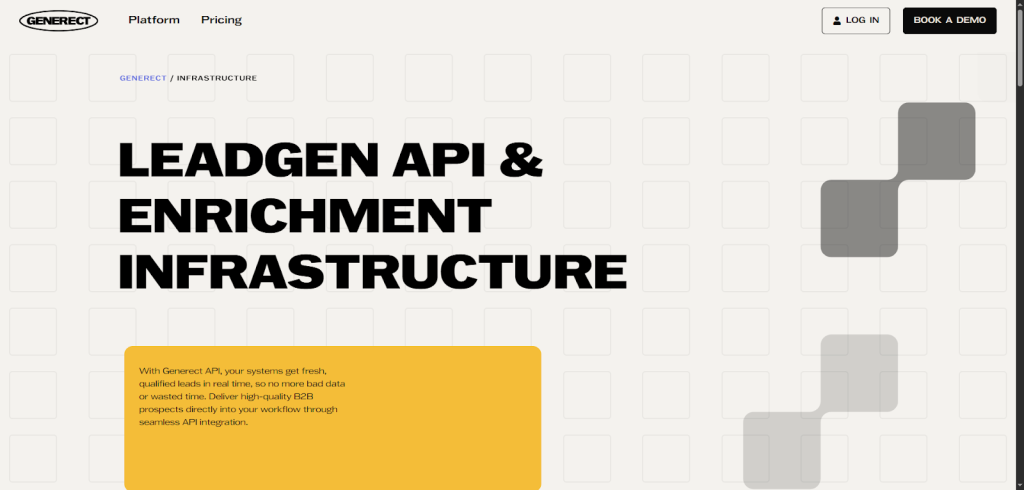
Generect’s API hooks you up with live B2B lead data, so you’re always working with fresh, verified contacts. Instead of chasing outdated lists, you get real-time email validation and lead enrichment that fit right into your sales or marketing workflow.
This means fewer bounces and faster outreach to the right decision-makers, helping you close deals without the usual guesswork.
Pros and cons:
- Pros → instant data updates, automated email validation, flexible filtering, easy CRM integration
- Cons → primarily B2B focused, pricing may scale with volume, learning curve for advanced filters
Pricing:
Generect uses a pay-as-you-go model starting with free searches. You only pay when you find valid contacts: $0.03 per verified email and $0.02 per export. Enterprise plans offer volume discounts, unlimited free searches, and 24/7 customer success support for large-scale lead generation.
What makes it stand out?
It’s all about speed and accuracy. Generect delivers real-time insights, so you never waste time on stale leads. The catch-all domain checks, AI-driven email finder, and seamless CRM integrations set it apart for teams needing fresh data fast.
Quick facts:
- Best for → SMBs, mid-market, enterprises, and startups moving fast
- Use cases → real-time prospecting, clean email lists, validating sign-ups, targeting decision-makers
- API capabilities → live email validation, bulk lead enrichment, catch-all detection, typo correction
- Integrations → supports major CRMs and sales tools like Salesforce, HubSpot, and Mailchimp
- Free trial → yes, available
- Automation level → fully automated and API-driven
- Setup time → minutes to integrate with clear REST API endpoints
Generect is perfect if you rely on up-to-date B2B leads and want to automate validation without lifting a finger. It’s a powerhouse for sales and marketing teams that need data accuracy at lightning speed.
Experience Generect in action
You’ve read what it does — now see it yourself. Connect Generect’s API in minutes and watch your bounce rate drop instantly.
ZeroBounce
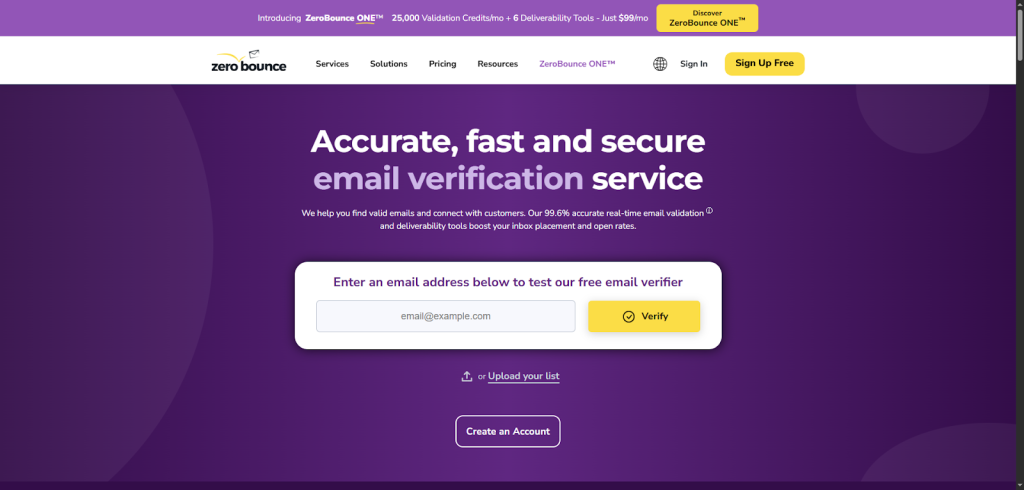
ZeroBounce is an email verification API that helps you keep your email lists clean and your campaigns effective. It checks email addresses in real time or bulk to catch invalid and risky contacts, like spam traps and disposable emails.
By doing this, it improves your email deliverability, prevents bounces, and maintains your sender reputation, so your messages land where they should.
Pros and cons:
- Pros → enterprise-grade accuracy, practical tools like spam trap detection, strong deliverability insights, easy integration, and 24/7 customer support.
- Cons → free tier has limited credits, and deeper features may require higher-tier plans.
Pricing:
ZeroBounce offers pay-as-you-go pricing starting with 100 free monthly credits for business or premium domains. After that, you buy credits or subscriptions with flexible plans and enterprise options.
What makes it stand out?
ZeroBounce stands out for its combo of high accuracy and smart insights that matter to you, detecting spam traps, scoring deliverability, and helping you manage your sender reputation effortlessly.
Plus, it fits smoothly into your workflow with multi-language SDKs and quick setup.
Quick facts:
- Best for → solo entrepreneurs to large enterprises
- Use cases → cleaning lists, validating sign-ups, avoiding fake or harmful emails
- API capabilities → real-time and bulk email validation, spam trap and catch-all detection, typo correction, deliverability scoring
- Integrations → works well with popular CRMs and email platforms via API
- Free trial → yes, with 100 free monthly credits
- Automation level → fully automated and API-driven
- Setup time → minutes to integrate using their REST API
ZeroBounce is ideal for teams that care deeply about deliverability and sender reputation. It’s a solid all-rounder that combines precision, insights, and support you can count on.
NeverBounce

NeverBounce is a fast, bulk email list cleaner designed to get your marketing campaigns ready without the hassle.
It’s an email verification API that checks and validates emails in real time or in large batches, helping you avoid bounce backs and keep your sender reputation strong.
You’ll keep your outreach clean and effective by cutting out fake, invalid, or disposable addresses before you hit send.
Pros and cons:
- Pros → quick verifications, easy-to-understand reports, and solid API support.
- Cons → no free tier, and bulk processing limits apply on lower plans.
Pricing is simple: pay-as-you-go with prices dropping as you verify more emails. There’s a free trial to try it out, plus enterprise options for bigger needs.
What makes NeverBounce stand out is its super-fast bulk email verification, great accuracy, typo correction, and anti-spam trap detection. Plus, it connects smoothly with marketing tools like HubSpot, Mailchimp, and Salesforce.
Quick facts:
- Best for → solo users, small to mid-market businesses, and enterprises
- Use cases → cleaning email lists, validating sign-ups, blocking fake or disposable emails
- API features → real-time checks, bulk validation, catch-all domain detection, typo fixes
- Integrations → works with HubSpot, Mailchimp, Salesforce, and 80+ others
- Free trial → yes
- Automation → fully automated and API-driven
- Setup time → just minutes to integrate via REST API
NeverBounce is your go-to if you handle large lists and want fast, no-fuss results. It’s built for marketers who value both speed and simplicity.
Clearout

Clearout is an email verification API that checks if email addresses are real and valid, either one by one or in large batches.
It fits perfectly into marketing and sales workflows by stopping fake signups and typos right when contacts enter their information, especially through CRM forms. This helps you keep your email list clean, boost deliverability, avoid bounces, and protect your sender reputation.
Pros and cons:
- Pros → fast real-time verification, easy CRM integrations, catches typos and fake emails at signup, supports bulk and single checks
- Cons → no completely free tier beyond initial credits, some features best suited for growing plans
Pricing:
You pay based on credits with pricing starting affordably for small users. You get 100 free credits at signup to test it out, and enterprise options are available if you need more power.
What makes it stand out?
Clearout shines because it works right at the entry point, filtering bad emails instantly in forms connected to your CRM or marketing tools.
It’s got smart typo correction and catches disposable or spammy addresses before they hit your lists, saving you time and protecting your sender score.
Quick facts:
- Best for → solo marketers, SMBs, growing teams, enterprises
- Use cases → stopping fake signups, catching typos on forms, cleaning bulk email lists
- API capabilities → real-time email verification, bulk checks, catch-all detection, typo fixes
- Integrations → HubSpot, Apollo, Lemlist, ActiveCampaign, Mailchimp, Jotform, Google Sheets, Zapier, WordPress
- Free trial → yes, 100 free credits with no credit card required
- Automation level → fully automated via API with webhook support
- Setup time → a few minutes to integrate with REST API in any programming language
Clearout shines when you need to stop fake signups at the source. It’s a practical pick for businesses that want real-time protection and cleaner databases from day one.
Emailable

Emailable is an email verification API that helps you clean up your email lists by checking addresses in real time or in bulk. You’ll get rid of invalid or risky emails before they cause bounces, keeping your sender reputation intact and boosting deliverability.
It’s designed with small teams in mind, so if you’re not a developer, you’ll still find it straightforward and practical to use.
Pros and cons:
- Pros → super easy setup, clear reports, reliable results, and great for small teams without coding skills.
- Cons → no free tier beyond initial credits, and some advanced bulk features need a paid plan.
Pricing:
Emailable offers a pay-as-you-go pricing model starting with 250 free credits to try out. From there, you buy credits as you need them, with options for monthly plans and enterprise packages available.
What makes it stand out?
What sets Emailable apart is its simple, no-code focus tailored for small and medium businesses.
You get instant, accurate checks without a steep learning curve, along with helpful features like typo correction and catch-all detection, all within a user-friendly interface that doesn’t require developer help.
Quick facts:
- Best for → small teams, SMBs, and businesses looking for simple email validation
- Use cases → cleaning email lists before campaigns, validating sign-ups, stopping fake or disposable emails
- API capabilities → real-time verification, bulk checks, typo fixes, and catch-all detection
- Integrations → connects easily with popular tools via API, no deep tech setup needed
- Free trial → yes, 250 free credits included
- Automation level → fully automated and API-driven but easy enough to handle without coding
- Setup time → just a few minutes to integrate and start verifying emails
Emailable makes list cleaning effortless, even if you’re not tech-savvy. It’s a friendly, reliable tool for small teams that want quick, accurate results without the complexity.
One API, all the verification you need
From signups to sales workflows, Generect keeps every contact verified, so you can focus on growing — not cleaning.
Bouncer
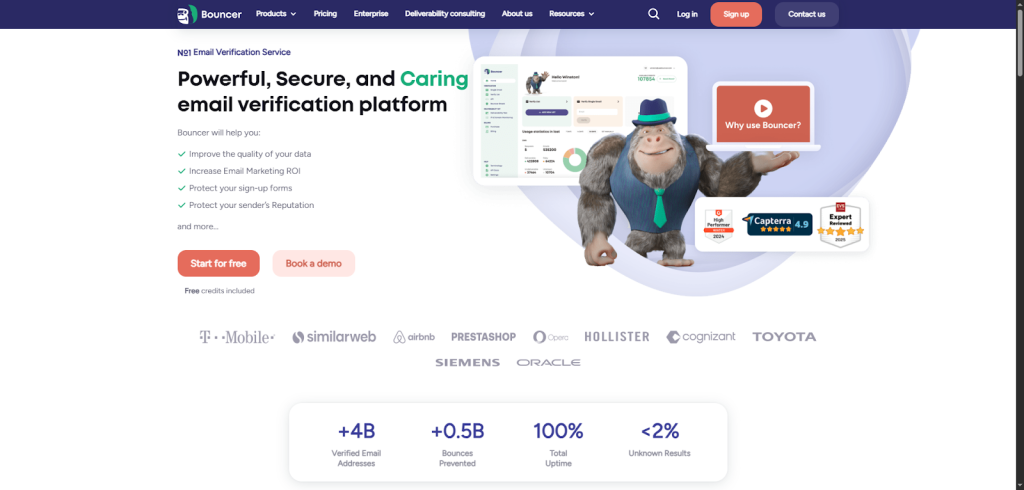
Bouncer is a developer-friendly email verification API designed with SaaS products in mind. It lets you easily add real-time email validation inside your apps and signup forms, so you don’t lose leads due to mistyped or fake emails.
You’ll get instant feedback on whether an email is deliverable, helping you keep your email lists clean, prevent bounce backs, and protect your sender reputation. It’s a powerful yet super-simple service to integrate for seamless email verification.
Pros and cons:
- Pros → fast real-time verification, simple integration, detailed data on emails, reliable uptime
- Cons → no free tier, advanced features require higher plans
Pricing:
Bouncer offers pay-as-you-go and monthly credit plans starting affordable for small teams, with scalable enterprise options and a free trial to test it out.
What makes it stand out?
Bouncer shines with high accuracy even on tricky catch-all addresses, instant API responses, excellent security features, and effortless connections to popular marketing platforms like HubSpot and Mailchimp.
Quick facts:
- Best for → solo developers, SMBs, Mid-Market, and Enterprise
- Use cases → cleaning email lists, validating sign-ups in real time, blocking disposable or fake emails
- API capabilities → real-time email checks, bulk validation, catch-all detection, typo correction
- Integrations → HubSpot, Mailchimp, Salesforce, and many more
- Free trial → yes, you can try before committing
- Automation level → fully automated and API-driven
- Setup time → just minutes to integrate with REST API
Bouncer is a great fit for developers who want power and precision in one neat package. It’s fast, secure, and ideal for SaaS products that need real-time accuracy.
Maileroo
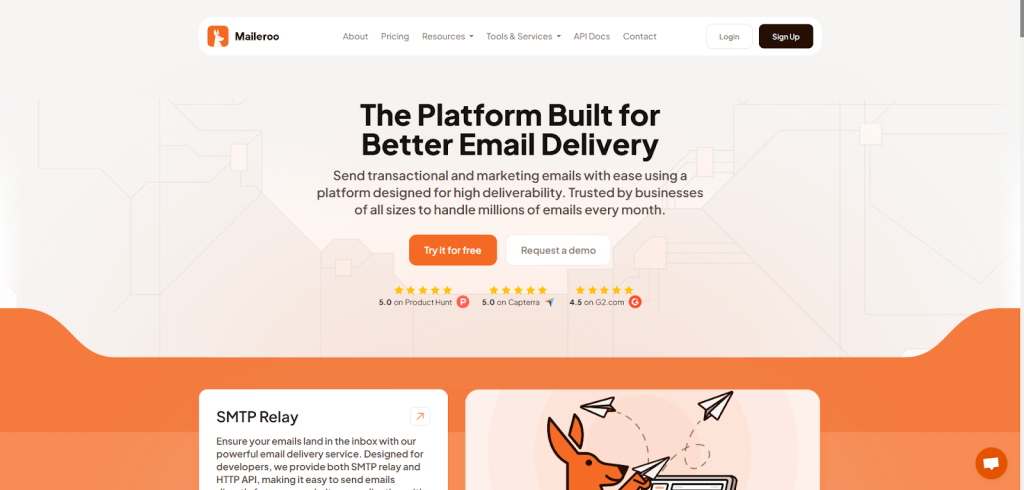
Maileroo is a simple yet powerful tool that combines email verification and sending in one place. You can quickly check if email addresses are valid and then send your transactional or marketing emails without juggling multiple services.
This means fewer bounced emails and better deliverability, helping you keep your sender reputation strong with less hassle.
Pros and cons:
- Pros → easy all-in-one solution, real-time verification, reliable email delivery, quick setup
- Cons → mainly focused on combined use cases, may be more than needed if you only want one feature
Pricing:
Maileroo offers pay-as-you-go and subscription plans starting with a free tier to test the waters. They also have options for bigger needs and enterprise clients, making it flexible for different budgets.
What makes it stand out?
What sets Maileroo apart is how it blends email address validation with smooth transactional email sending in one place. You get real-time verification and fast, dependable delivery all wrapped up together, plus GDPR compliance and solid analytics to keep you on track.
Quick facts:
- Best for → solo users, small to mid-sized businesses, and enterprises looking for a unified email solution
- Use cases → cleaning email lists, verifying sign-ups, sending transactional and marketing emails
- API capabilities → real-time and bulk email verification, SMTP relay, inbound routing, analytics
- Integrations → works well with web apps and developer tools via REST API and SDKs
- Free trial → yes, includes a free tier
- Automation level → fully automated and API-driven for smooth workflows
- Setup time → just minutes to connect and start sending or verifying emails
Maileroo is perfect if you want a one-stop shop for sending and verifying emails. It simplifies your workflow while keeping your sender reputation spotless.
Abstract API Email Validation
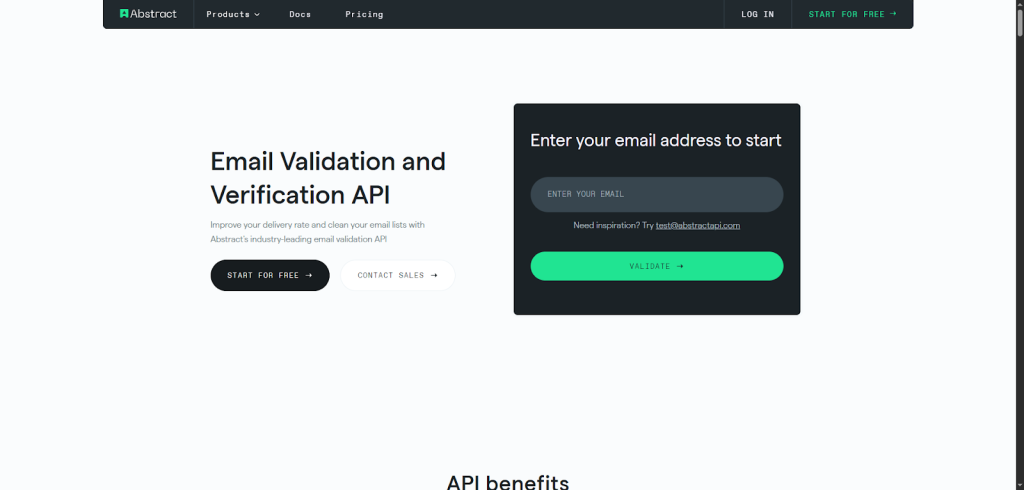
Abstract’s Email Validation API checks email addresses in real time or batches to make sure they’re valid and safe to send to. It’s perfect if you want to keep your email lists clean, avoid bounces, and protect your sender reputation.
It fits naturally into marketing and sales workflows, especially if you’re already using Abstract’s other APIs like IP intelligence or geolocation, helping you quickly confirm if an email is legit during sign-ups or outreach.
Pros and cons:
- Pros → fast and accurate checks, easy to use, good for bulk validations, and solid integration options.
- Cons → free tier is limited to 100 requests, and advanced features require a paid plan.
Pricing:
You can start for free with 100 validations per month. Paid plans begin at $17/month focused on larger volumes and more features. Enterprise deals are available for big needs and custom setups.
What makes it stand out?
It works quickly and reliably with deep checks like SMTP verification, typo correction, and disposable email detection. Plus, since it’s part of Abstract’s ecosystem, it plays nicely with other tools like HubSpot, Salesforce, and Mailchimp for a smoother workflow.
Quick facts:
- Best for → solo users, small to mid-sized businesses, and enterprises
- Use cases → cleaning up email lists, verifying new sign-ups, blocking disposable or risky emails
- API capabilities → real-time and bulk email validation, typo detection, catch-all and disposable email flagging
- Integrations → Salesforce, HubSpot, Mailchimp, Zapier, AWS, GCP, Azure, and more
- Free trial → yes, with 100 free requests per month
- Automation level → fully automated with API-driven workflows
- Setup time → just minutes to integrate through a simple REST API
Abstract is a smart choice if you’re already using their other APIs or want deep, reliable checks. It’s fast, flexible, and built for teams that value consistency across tools.
SendGrid
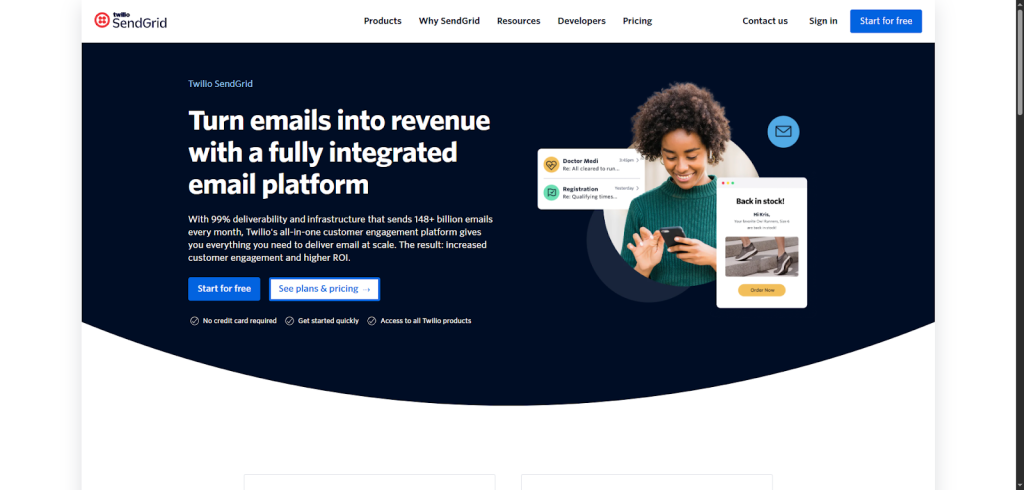
SendGrid is an email delivery platform that includes a smart email validation API built right into its system. It checks email addresses for typos, fake, inactive, or disposable status as you send or in bulk, helping you clean your lists automatically.
This means fewer bounces and better chances your emails actually reach real people, keeping your sender reputation strong without extra hassle.
Pros and cons:
- Pros → seamless integration with sending workflow, real-time validation, uses machine learning, avoids spammy verification methods
- Cons → email validation only on higher-tier plans, pay-per-validation after limits, no standalone free tier for validation
Pricing:
SendGrid offers tiered subscriptions with email validation included in Pro and Premier plans. After you hit the included limit, you pay per validation. There’s a free plan for sending emails, but email validation requires upgrading.
What makes it stand out?
What’s great about SendGrid is that the validation is built right into your email sending process, with no separate tools needed.
It uses smart machine learning models, is gentle on mailbox providers, and catches typos and disposable emails instantly, so you keep a good sender reputation without extra work.
Quick facts:
- Best for → startups, SMBs, Marketers, Enterprises sending high volumes
- Use cases → validating sign-ups, cleaning lists on the fly, blocking fake emails at capture
- API capabilities → real-time validation, bulk checks, typo detection, checks for disposable/shared emails
- Integrations → native to SendGrid’s email platform, works well with Twilio ecosystem
- Free trial → free plan available for email sending, validation needs upgrade
- Automation level → fully automated, works seamlessly during sending or via API calls
- Setup time → just minutes to integrate using SendGrid’s easy REST API and get started
SendGrid stands out if you want validation built right into your email-sending process. It keeps things seamless, smart, and efficient without juggling extra tools.
Integration in minutes, not hours
Generect’s REST API connects to your favorite tools in just a few clicks — no heavy coding, no stress, all accuracy.
EmailListVerify

EmailListVerify is an email verification API that helps you keep your email lists clean and healthy. Whether you’re verifying emails one by one or in bulk, it checks addresses in real time to stop invalid ones from slipping in.
This means fewer bounces, better deliverability, and a stronger sender reputation, making it perfect for sales and marketing teams focused on cold outreach.
Pros and cons:
- Pros → super accurate bulk verification, easy integration, real-time checks, and clear results.
- Cons → no free tier after the trial, some features limited on lower plans.
Pricing:
EmailListVerify offers pay-as-you-go pricing with starting plans that include free credits to test. They also have monthly and enterprise options to fit different business sizes.
What makes it stand out?
It stands out with its accuracy-first approach made specifically for cold outreach teams. You get fast responses, spot disposable or catch-all emails, and benefit from handy integrations with tools like Mailchimp and Shopify.
Quick facts:
- Best for → solo users, SMBs, mid-market, and enterprise teams
- Use cases → cleaning email lists, preventing fake sign-ups, blocking disposable emails
- API capabilities → real-time email validation, bulk verification, catch-all detection, and typo fixing
- Integrations → Mailchimp, Shopify, Rackspace, and others
- Free trial → yes, with 100 free verifications
- Automation level → fully automated and API-driven
- Setup time → minutes, just plug into your forms or workflows
EmailListVerify is all about accuracy and dependability for outreach-heavy teams. It’s perfect for marketers who live and die by clean data.
Verifalia
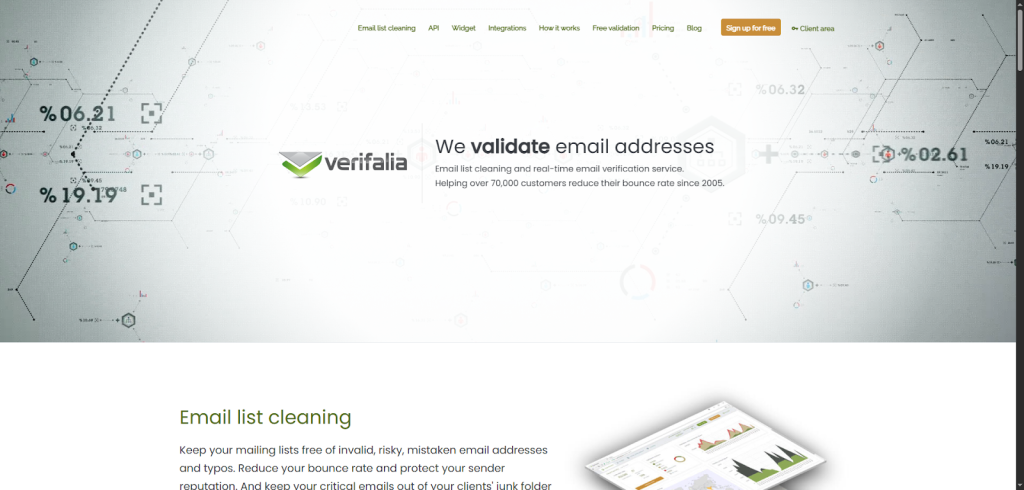
Verifalia is an email verification service designed to check and clean your email lists, either one address at a time or in bulk.
You’ll learn how it fits right into your marketing or sales workflow by verifying emails in real time or batches, helping you reduce bounce rates and protect your sender reputation.
It’s a straightforward email verification API that delivers detailed results for smarter decision-making.
Pros and cons:
- Pros → provides rich, detailed verification reports, highly customizable API settings, easy integration with multiple SDKs, and 99% accuracy.
- Cons → free tier comes with limited credits, and advanced features require higher-tier plans.
Pricing:
Verifalia offers flexible pricing with monthly plans starting for free, plus bulk credit packs that scale with usage. There’s a free tier to get you started and enterprise options if you need more power.
What makes it stand out?
What sets Verifalia apart is its detailed verification reports with over 40 unique status codes and customizable API options you can fine-tune to fit your exact needs.
Plus, it supports global emails, detects risky addresses, and integrates seamlessly with popular tools like HubSpot, Mailchimp, and Salesforce.
Quick facts:
- Best for → solo users, SMBs, Mid-Market, Enterprise
- Use cases → cleaning email lists, validating sign-ups, blocking fake or disposable emails
- API capabilities → real-time checks, bulk validation, catch-all detection, typo fixes
- Integrations → HubSpot, Mailchimp, Salesforce, Google Sheets, Zapier, and over 6,000 others
- Free trial → yes, with limited monthly credits
- Automation level → fully automated, API-driven
- Setup time → minutes to integrate via REST API and ready-to-use SDKs
Verifalia is great if you love detailed insights and customization. It’s a top-tier choice for teams that want more than just a simple yes-or-no result.
MyEmailVerifier

MyEmailVerifier is a straightforward email verification API and service that checks email addresses in real time or in bulk. It helps you keep your marketing or sales email lists clean by finding invalid, fake, or risky emails.
This means you’ll reduce bounces, avoid spam traps, and keep your sender reputation healthy, which makes your campaigns more effective.
Pros and cons:
- Pros → affordable pricing, easy-to-use API, reliable results, daily free credits
- Cons → free tier limits to 100 daily verifications, no social data append
Pricing:
MyEmailVerifier offers pay-as-you-go and monthly subscription plans starting at about $5 for 1,000 emails, with 100 free verifications daily. There are discounted prices for larger volumes and enterprise options available.
What makes it stand out?
It’s one of the most budget-friendly options for startups and small businesses needing accurate email checks at scale. You get solid deliverability guarantees, strong spam trap detection, and easy API integration with no fluff, just practical results.
Quick facts:
- Best for → startups, SMBs, mid-market
- Use cases → cleaning email lists, verifying sign-ups, avoiding fake or disposable emails
- API capabilities → real-time verification, bulk validation, catch-all detection, typo correction
- Integrations → works well with popular ESPs and marketing platforms
- Free trial → yes, 100 free email verifications daily
- Automation level → fully automated and API-driven
- Setup time → quick setup, just minutes via REST API
MyEmailVerifier proves you don’t need big budgets to get reliable results. It’s a budget-friendly, trustworthy pick for startups and growing teams.
Proofy.io

Proofy.io is a lightweight email verification API that makes checking emails quick and easy.
It fits perfectly into your marketing or sales workflows by verifying and validating email addresses instantly or in batches, helping you improve deliverability, avoid bounces, and keep your sender reputation solid.
This no-frills service keeps your lists clean without any hassle.
Pros and cons:
- Pros → fast verification, minimal setup, simple API, reliable results
- Cons → no free tier, limited free trial credits, best for smaller batches
Pricing:
Proofy.io uses a pay-as-you-go model starting at $4 for 1,000 credits with a small trial purchase. There’s no free tier, but you can get test credits by reaching out with a company email. Enterprise plans are available.
What makes it stand out?
It’s all about speed and ease, as Proofy.io offers instant verification with very little setup. It’s perfect for quick checks or small batches without overcomplicating things. Plus, it’s secure and comes with clear, simple docs to get you started fast.
Quick facts:
- Best for → solo users, small businesses, startups
- Use cases → cleaning email lists, validating sign-ups, avoiding disposable or fake emails
- API capabilities → real-time checks, batch validation, syntax and domain verification
- Integrations → works with popular CRMs and marketing tools via API
- Free trial → not free, but you can buy low-cost trial credits
- Automation level → fully automated API-driven process
- Setup time → minutes to integrate via REST API
Proofy.io is built for simplicity and speed. If you just want quick, accurate verifications without extra setup, it’s a solid, straightforward choice.
Reoon Email Verifier API
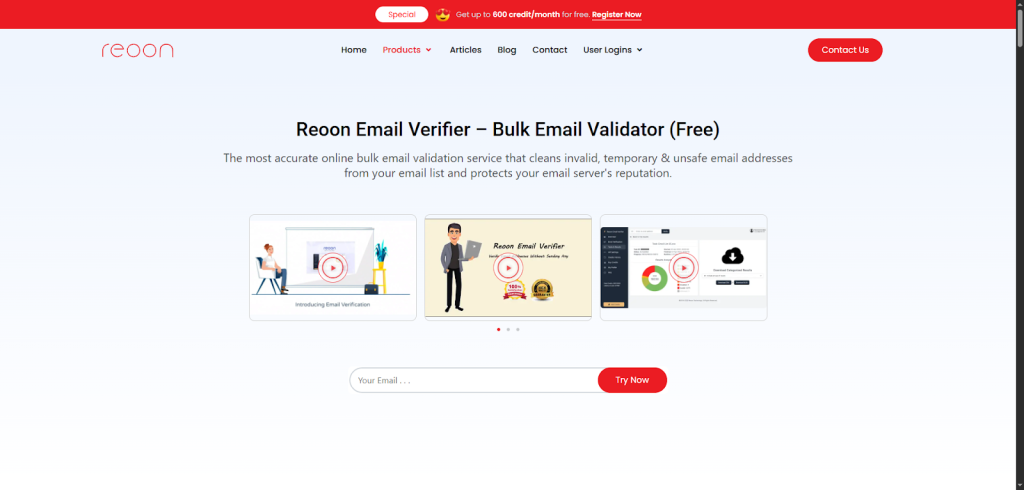
Reoon’s API helps you clean up your email lists by verifying addresses both in real time and in bulk. It catches invalid, temporary, and risky emails so you only send to real, safe contacts.
This keeps your campaigns sharp, bounce rates low, and sender reputation strong. It’s a straightforward email verification service that fits right into your marketing or onboarding workflow, making sure the emails you rely on really work.
Pros and cons:
- Pros → fast verifications (within half a second), high accuracy over 99%, smart AI scoring, detects spam traps and temporary emails, and easy bulk processing.
- Cons → no free tier beyond 600 monthly credits, and it relies on credits which take some getting used to.
Pricing:
Reoon offers a free tier with 600 monthly credits and no credit card needed. Paid plans are credit-based, starting at around $12 for 10,000 credits with no expiration, plus monthly plans from $9 for daily usage.
There’s flexibility whether you verify tons of emails at once or prefer steady daily checks.
What makes it stand out?
Reoon shines with its AI-powered email scoring and intelligent spam trap detection, helping you avoid risky addresses.
It’s super quick with live API checks in under half a second and smartly detects tricky temporary emails other tools miss. Plus, it easily fits into your existing tools via its REST API, so you keep things automated without hassle.
Quick facts:
- Best for → solo entrepreneurs, SMBs, mid-market, and enterprises
- Use cases → cleaning up email lists, verifying sign-ups live, blocking fake or disposable emails
- API capabilities → real-time verification, bulk uploads, catch-all checks, typo fixes, spam trap detection
- Integrations → works easily with WordPress forms and other systems through API
- Free trial → yes, 600 free credits per month without a credit card
- Automation level → fully automated, API-driven with instant responses
- Setup time → just minutes to integrate via REST API
Reoon is ideal for anyone who values accuracy and automation powered by AI. It’s fast, smart, and flexible enough to handle everything from small lists to enterprise loads.
EmailDetective
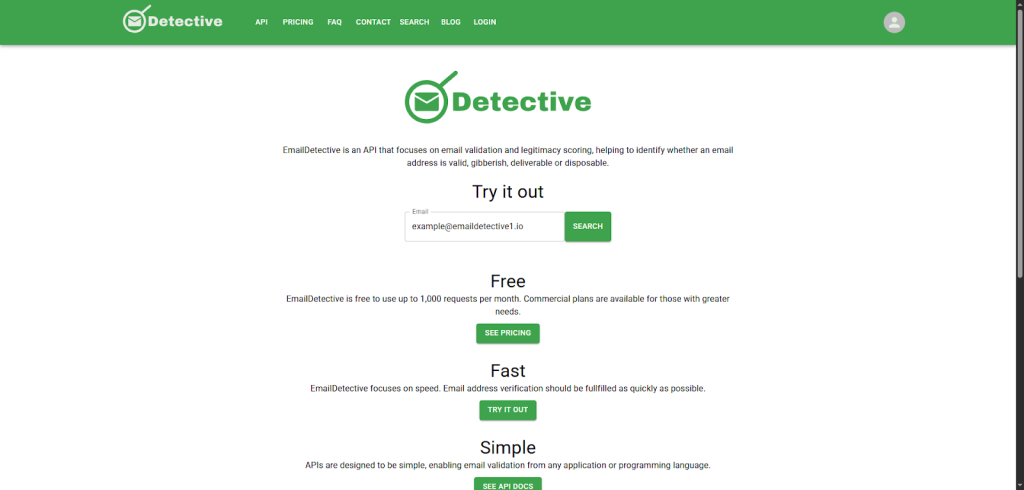
EmailDetective is an email verification API that helps you quickly check if an email address is real, risky, or fake. It works like a fraud detective by spotting gibberish, disposable, or suspicious emails using behavioral analysis.
This helps you keep your email lists clean, avoid bounces, and protect your sender reputation, making it perfect for marketing, sales, or onboarding workflows that need trustworthy contacts.
Pros and cons:
- Pros → fast checks, simple API, free tier with 1,000 emails per month
- Cons → limited free usage, mainly focused on email legitimacy scores rather than deep integrations
Pricing:
EmailDetective offers a free tier with 1,000 validations every month. Paid plans are available if you need more, with flexible options for commercial users. No complicated subscriptions, just easy scaling when you grow.
What makes it stand out?
It stands out by acting like a forensics expert, spotting fake and risky emails using behavior clues, not just syntax. It’s super fast, simple to use, and built to catch tricky disposable or suspicious email addresses.
Quick facts:
- Best for → solo users, small and mid-sized businesses
- Use cases → cleaning email lists, catching fake sign-ups, blocking disposable emails
- API capabilities → real-time checks, bulk validation, detecting gibberish and disposables
- Integrations → works easily with any app via REST API (no heavy plug-ins)
- Free trial → yes, 1,000 free email validations per month
- Automation level → fully API-driven, quick to set up
- Setup time → only minutes to integrate, just plug in and start verifying
EmailDetective is the perfect lightweight solution for catching fake or risky emails early. It’s simple, fast, and a great fit for anyone who wants dependable results with minimal setup.
Each of these tools brings something unique to the table, from speed and accuracy to powerful integrations and flexible pricing. The right choice depends on what you need most: bulk cleaning, real-time checks, or seamless CRM connections.
The best email verification API is the one that fits easily into your workflow and helps you focus on reaching real people, not fake inboxes.
Whatever your goals for 2025, using a reliable verification API will keep your emails clean, your deliverability high, and your campaigns performing their best.
So, how can you make the right choice? Let’s take a look at a comparison of these tools to help you make your decision more easily.
How do these tools compare side by side?
Choosing among the top email verification APIs can be tricky because each one promises accuracy, speed, and seamless integration.
But the real difference lies in how they perform when it counts: real-time checks, API reliability, and cost. So, let’s break it down clearly.
Here’s a quick look at how these tools stack up:
| Tool | Accuracy | Speed | API support | Avg. price / 1,000 verifications* |
| Generect API | 99%+ | Real-time | Excellent REST API + MCP | ~$50 |
| ZeroBounce | 99%+ | Fast | SDKs + REST API | ~$15 |
| NeverBounce | 99% | Very Fast | Strong REST API | ~$8 |
| Clearout API | 98–99% | Fast | REST + Webhooks | ~$10 |
| Emailable | 98% | Moderate | Simple API | ~$10 |
| Bouncer | 99% | Very Fast | Developer-friendly | ~$7 |
| Maileroo | 97% | Fast | Integrated API + SMTP | ~$9 |
| Abstract API | 98% | Fast | Reliable REST API | ~$12 |
| SendGrid | 98–99% | Real-time | Built-in API | ~$14 |
| EmailListVerify | 99% | Very Fast | Solid REST API | ~$7 |
| Verifalia | 99% | Fast | Advanced SDKs | ~$10 |
| MyEmailVerifier | 98–99% | Moderate | Simple REST API | ~$6 |
| Proofy.io | 97% | Fast | Basic API | ~$9 |
| Reoon API | 99%+ | Ultra-fast | Smart REST API | ~$6 |
| EmailDetective | 96–98% | Fast | Lightweight REST API | Free–$5 |
*Approximate pricing; may vary by volume or plan.
Now, let’s talk about trade-offs. If you want real-time email verification API performance, Generect, Reoon, Bouncer, and NeverBounce deliver sub-second responses. For accuracy and analytics, Generect, ZeroBounce, and Verifalia lead the way.
Cheaper tools like MyEmailVerifier and EmailListVerify still perform well but trade some reporting depth for affordability.
Meanwhile, Maileroo and SendGrid stand out for combining validation with email delivery, making them perfect if you want everything in one place.
Pick what matches your goals: speed for developers, insights for marketers, or simplicity for startups. Once you know your priorities, choosing the right API gets easy. And how exactly can this be done? Let’s take a look below.
Let Generect power your email success
Real-time validation. Seamless integration. Zero guesswork. Everything your email strategy needs in one API.
What’s the best option for your business size or goal?
Not every email verification service API fits every type of business. The right choice depends on where you are in your journey, whether you’re coding solo, managing client campaigns, or running an enterprise platform.
Let’s break it down so you can match your needs with the right kind of tool.
For startups and indie developers
If you’re just getting started, you need something affordable, quick to set up, and developer-friendly. Go for tools like Generect, Reoon, MyEmailVerifier, or Proofy.io.
They’re simple to integrate, cost-effective, and give you solid accuracy without overcomplicating things. Look for APIs with clear documentation and free trial credits, which are perfect for testing as you grow.
For marketing agencies
Agencies live by deliverability and scale. You’ll want an email verification service API that supports bulk validation, detailed analytics, and smooth CRM integrations.
Generect, ZeroBounce, Clearout, and NeverBounce are top picks in this category, as they all offer real-time validation, excellent reporting, and automation options to keep campaigns clean and clients happy.
For enterprise-level platforms
Big teams need reliability, speed, and customization. Tools like Generect API, Bouncer, and Verifalia shine with enterprise-grade uptime, detailed reporting, and flexible API endpoints that fit into large systems.
These platforms scale easily and come with advanced features like catch-all detection, webhook support, and dedicated account management.
For privacy-focused or EU-based businesses
If compliance and data protection are your top priorities, choose a GDPR-compliant provider that hosts data within the EU.
Verifalia and Clearout are strong options, offering EU data centers, strict privacy controls, and transparent security policies.
Pick an API that fits your business stage, not just your budget. Start lean, grow smart, and when you scale, move to a platform that can handle volume without sacrificing accuracy or privacy.
Next, let’s look at how to integrate these tools into your workflow.
How do you integrate an email verification API into your workflow?
Once you’ve picked your favorite email address verification API, the next step is getting it to work smoothly inside your everyday tools.
It’s easier than you might think and you don’t need to be a coding wizard to do it. Most APIs use simple REST endpoints, so you can verify an email with just one request. For example:
POST https://api.example.com/verify
{
“email”: “[email protected]”,
“api_key”: “YOUR_KEY”
}
You’ll get a quick JSON response like: {“status”: “valid”, “score”: 0.98}. It means the address is safe to use.
If you prefer something plug-and-play, most providers also offer SDKs for languages like Python, PHP, or Node.js. That way, you can drop verification right into your existing app logic.
Now, let’s talk about real use cases:
- Signup forms → add verification before users hit “Submit” to stop fake or mistyped emails from entering your system.
- CRMs and email tools → connect your email address verification API to platforms like HubSpot or Salesforce so every new contact is automatically checked before it lands in your database.
Want to automate it even further? You can! Tools like Zapier, Make (Integromat), or Node.js scripts make it easy to trigger verification when new leads come in, with no manual work required.
For instance, every time someone fills out a form or joins your newsletter, a quick check runs behind the scenes, keeping your list squeaky clean.
The key is to start small: connect one form or list, test your flow, and then scale up. Once you automate it, you’ll never have to worry about fake signups or high bounce rates again because your system will quietly handle it all for you.
It all sounds appealing. But how much will it cost you? Let’s find out.
How much should you expect to spend?
Before you choose a tool, it helps to know what’s normal when it comes to pricing.
Email verification API pricing in 2025 is more transparent and flexible than ever, but it still varies depending on what you’re doing and how often you verify.
Most providers follow a “pay-as-you-go” or credit-based model, so you only pay for what you use. The price per verification usually drops as your volume grows. In general, here’s what you can expect across the market this year:
| Volume | Average cost per 1,000 verifications | Example use case |
| 1,000–10,000 | $6–$15 | Small lists, new campaigns |
| 10,000–100,000 | $4–$8 | Mid-sized teams or agencies |
| 100,000+ | $2–$5 | Enterprises, ongoing automation |
You’ll also find some free tiers, typically offering 100–500 monthly checks, which are great for testing before scaling up.
Now, how do you keep costs low without sacrificing quality? A few smart habits go a long way:
- Verify early → сlean emails at signup or capture, not after a campaign fails. It saves credits and prevents bounces.
- Automate checks → use workflows with tools like Zapier or your CRM so you’re only verifying new data, not the same addresses twice.
- Bundle or plan ahead → many vendors offer big discounts for prepaid or annual plans, which is perfect if you verify emails in bulk.
Email verification API pricing in 2025 is built to scale with you. Start small, watch your usage, and let automation handle the rest. That’s how you keep your lists clean without overspending.
But what about the pitfalls? Is there anything you should watch out for? Let’s take a look.
Are there any risks or limitations?
Even the best API for email verification isn’t perfect. While these tools save time and protect your sender reputation, they come with a few limitations you should know about and ways to handle them smartly.
One common issue is false positives, which happen when an address looks risky but is actually valid.
This usually happens with catch-all domains or strict mail servers. The fix? Don’t rely on a single check. Use real-time validation at signup and schedule periodic re-verifications to catch changes over time.
Consider rate limits and API downtime. Every service has limits on how many requests you can send per minute or hour. If you’re verifying large volumes, spread requests out or batch them in smaller chunks.
Most APIs provide status dashboards or webhook alerts, so use them to monitor uptime before your campaigns go live.
Also, never overlook data privacy. You’re handling real user emails, so pick a provider with GDPR compliance, encrypted endpoints, and data retention transparency.
Avoid storing raw emails unnecessarily; verify them first, then safely discard or hash them if possible.
Using an API for email verification is low-risk when done right. Plan your integration carefully, automate checks, and follow privacy best practices and you’ll stay accurate, compliant, and worry-free.
Now you know why email verification matters and which tools can help. It’s time to take action, but before that, let’s quickly recap.
Final thoughts
Using an email verification API isn’t just a nice extra. It’s essential if you want your messages to actually reach real people. Clean, verified data means fewer bounces, stronger deliverability, and better results from every campaign you send.
The best email verification API does more than just clean up your lists. It quietly keeps your systems running smoothly by checking addresses in real time, stopping bad data before it enters your CRM or signup forms.
That means fewer headaches later and more time to focus on growing your business.
There’s no single “perfect” tool for everyone. The right one depends on your workflow, tech stack, and goals. So don’t guess, test:
- Try two or three free APIs to compare accuracy, speed, and how easily they fit your system.
- Watch how they perform during real use, not just in demos or trials.
Once you find the one that feels effortless, you’ll see how much cleaner and more reliable your data becomes.
So go ahead and try a few free APIs before committing. You’ll quickly realize that the right verification API doesn’t just improve your lists; it powers up your entire email strategy for 2025 and beyond.